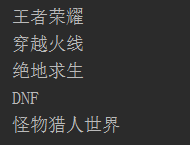List of items
1. What is a list
List is a variable data type
The list is represented by [] for each element, separated by commas. The list can contain anything and the object of the object
List can hold a large amount of data
lst = ["Zhao Si","ABC",123,["Ha-ha","Roar"],("I","call","element","group")]
2. Index and slice of list
Lists, like strings, have indexes and slices, but the cut out content is lists
lst = ["Zhao Si","Nicholas","Jack Ma","Wang Jianlin"]
print(lst[1])
print(lst[2])
print(lst[3])
Index subscript starts from zero
lst = ["Zhao Si","Nicholas","Jack Ma","Wang Jianlin"]
print(lst[0:2]) #['Zhao Si', 'Nicholas']
print(lst[:3]) #['Zhao Si', 'Nicholas', 'Jack Ma']
[start position: end position: step size]
II. Addition, deletion and modification of the list
1. increase
Note that list and str are not the same. lst can be changed, so they operate directly on the original object
#increase
lst = ["Zhao Si","Nicholas","Jack Ma","Wang Jianlin"]
lst.append("Lennon") #['Zhao Si', 'Nicholas', 'Jack Ma', 'Wang Jianlin', 'Lennon']
print(lst)
lst.insert(2,"Wen Dong Xie") #['Zhao Si', 'Nicholas', 'Wen Dong Xie', 'Jack Ma', 'Wang Jianlin', 'Lennon']
print(lst)
lst.extend(["Ultraman",123,"Garden baby"])#['Zhao Si', 'Nicholas', 'Wen Dong Xie', 'Jack Ma', 'Wang Jianlin', 'Lennon', 'Ultraman', 123, 'Garden baby']
print(lst)
2. delete
#Delete
lst = ["Zhao Si","Nicholas","Jack Ma","Wang Jianlin"]
data = lst.pop(3) #Return deleted data
print(data) #Wang Jianlin
print(lst) #['Zhao Si', 'Nicholas', 'Jack Ma']
lst.remove("Jack Ma") #Delete elements,No error will be reported
print(lst) #['Zhao Si', 'Nicholas']
del lst[1:3] #Slice deletion
print(lst) #['Zhao Si']
lst.clear() #Clear all
print(lst) #[]
3. changes
# change
lst = ["Glory of Kings","Cross Fire","Jedi survival","DNF","Monster Hunter world"]
lst[0] = "mine clearance"
print(lst) #['mine clearance', 'Cross Fire', 'Jedi survival', 'DNF', 'Monster Hunter world']
lst[3] = "Eating chicken"
print(lst) #['mine clearance', 'Cross Fire', 'Jedi survival', 'Eating chicken', 'Monster Hunter world']
lst[1:3] = ["Crazyracing Kartrider"] #Delete first,Post addition
print(lst) #['mine clearance', 'Crazyracing Kartrider', 'Eating chicken', 'Monster Hunter world']
lst[1::2] = ["QQ Fight against landlords","QQ Flying car"] #When the slice is modified,If the step size is not 1,Note the number of elements
print(lst) #['mine clearance', 'QQ Fight against landlords', 'Eating chicken', 'QQ Flying car']
4. check
List is an iterative object
lst = ["Glory of Kings","Cross Fire","Jedi survival","DNF","Monster Hunter world"]
for el in lst:
print(el)

5. Other operations
sort() sort default ascending
sort(reverse=True) descending
reverse() flip
len() for length
lst = ["upper","sea","yes","One","Temporary","sea","City"]
# c = lst.count("sea") #query"sea"Number of occurrences
# print(c)
lst = [77,3,52,6,11,7,88]
print(lst)
lst.reverse() #Reverse order [88, 7, 11, 6, 52, 3, 77]
print(lst)
lst.sort() #Ascending order,Default is ascending
print(lst) #[3, 6, 7, 11, 52, 77, 88]
lst.sort(reverse=True) #Descending order
print(lst) #[88, 77, 52, 11, 7, 6, 3]
Nesting of lists
Using dimension reduction operation, one layer at a time
lst = [1, "Tai Chi", "wusir", ["Painful pain", ["Coca Cola"], "Wang Jian Lin"]]
#find wusir
print(lst[2])
#Find Taibai and wusir
print(lst[1:3])
#Find white
print(lst[1][1])
# take wusir Get. And then write. Throw it back.
s = lst[2]
s = s.capitalize()
lst[2] = s
print(lst)
# Abbreviation
lst[2] = lst[2].capitalize()
print(lst)
# Replace Taiji with Taiji
lst[1] = lst[1].replace("A kind of", "A kind of")
print(lst)
# Replace A kind of pain with A kind of chemical pain
lst[3][0] = lst[3][0].replace("A kind of", "turn")
print(lst[3][0])
lst[3][1].append("Sprite")
print(lst)
Four Dian tuple
Tuple
Read only list. You can only read and do nothing
Use () for tuples
If there is only one element in the tuple (element,)
Empty tuple()
Tuple is an iteratable object, which can use for loop
tu = (1,"Li Bai","Du Fu","Bai Juyi","Wang Wei")
print(tu)
print(tu[0])
print(tu[2])
print(tu[3]) #Tuple slice or tuple
# for Cycle through the epoch group
for el in tu:
print(el)
Five, range
range(n) from 0 to n-1
range(m,n) from m to n-1
range(m,n,q) from m to n-1
Use the range and for loops to get the index in the list
for i in range (len):
i. index
List [i] elements
